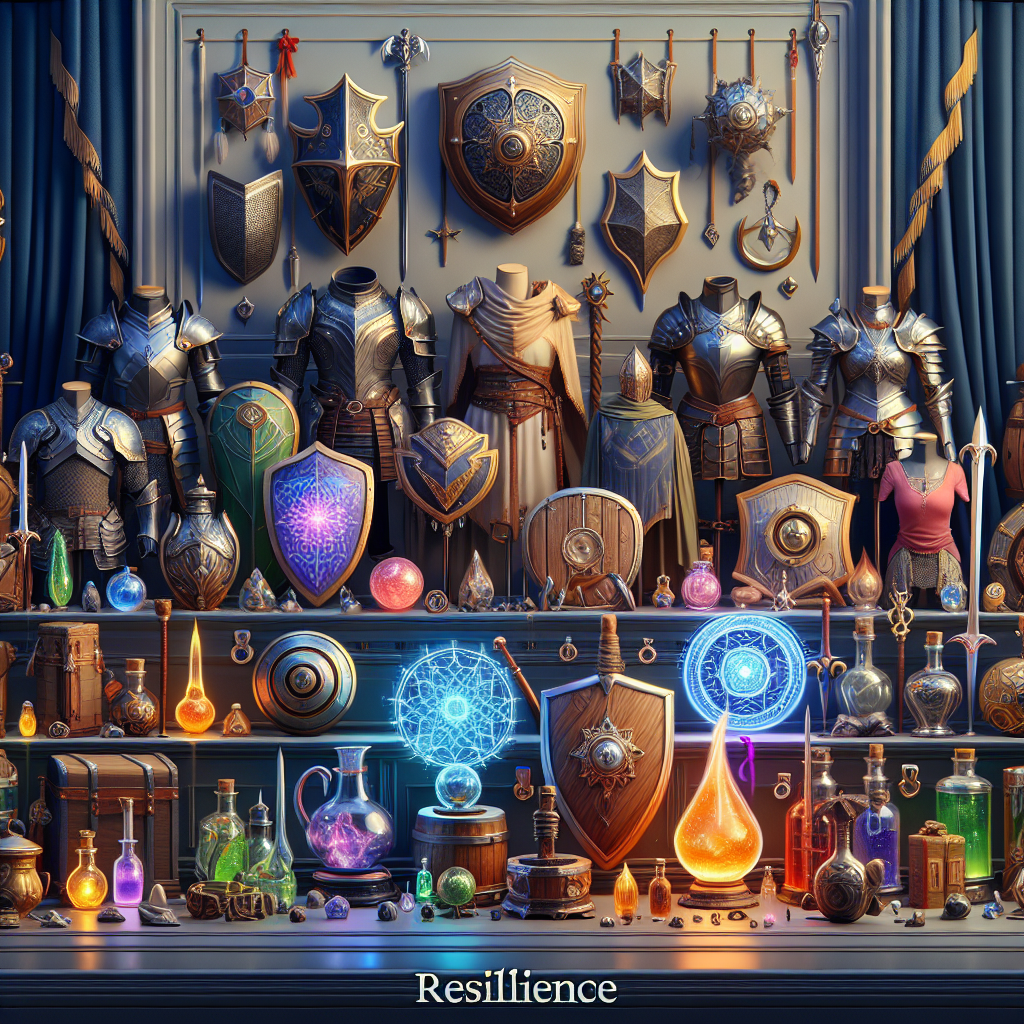As an Amazon Associate I earn from qualifying purchases.

Resilience is often compared to the strength and flexibility of a willow tree, which can bend without breaking in the face of a storm. This metaphor underlines the importance of resilience as a quality that allows individuals to withstand adversity and bounce back from challenges. The concept of “30 Spells for Building Resilimony” takes this metaphor and transforms it into a practical framework, providing actionable steps that people can use to fortify their emotional and psychological well-being.
Originating from the field of positive psychology, the phrase “30 Spells for Building Resilience” may not refer to actual magic spells, but rather to habits or actions that, when practiced consistently, contribute to building a person's inner strength. The “spell” metaphor adds a sense of enchantment and empowerment to the process of resilience-building, suggesting that an individual has the ability to conjure positive changes in their lives. Each of the 30 strategies is meant to help individuals develop coping mechanisms and a positive mindset that can protect against the negative effects of stress and trials.
Although resilience has always been a valuable trait, its significance has been magnified in contemporary times due to increasing stress levels in personal and professional life. The high prevalence of mental health issues, including anxiety and depression, has brought the need for resilience to the forefront. In fact, a staggering statistic from the American Psychological Association suggests that 75% of adults reported experiencing at least one symptom of stress in the past month, underscoring the urgency for resilience-building techniques like the “30 Spells.”
The “30 Spells” encompass a wide array of practices, such as mindfulness, gratitude journaling, and the cultivation of strong social support networks. These practices have scientific backing; for example, research has shown that mindfulness meditation can lead to changes in brain regions related to learning, memory, and emotion regulation, fostering resilience. Similarly, expressing gratitude has been linked to improved well-being and mental health, making it another potent “spell” for resilience.
Moreover, the “30 Spells” framework is designed to be versatile and adaptable, allowing individuals to choose and customize the spells that resonate with them the most. This personalized approach ensures that resilience-building becomes an integrated and enjoyable aspect of daily life, rather than a laborious task. Every “spell” is a tool for empowerment, enabling individuals to not only survive but also thrive in the face of life's inevitable challenges.
Building resilience enables individuals to adapt to life's adversities, bounce back from hardships, and manage stress effectively. Cultivating resilience isn't about toughing it out alone but rather involves developing emotional, psychological, and mental strategies that contribute to well-being. Here are 30 “spells”—metaphorical strategies—that can help in building resilience:
1. **Mindfulness Meditation**: Regular practice improves emotional regulation and cognitive flexibility, key components of resilience.
2. **Progressive Muscle Relaxation**: Helps to release physical tension and reduce stress, making it easier to cope with challenges.
3. **Positive Affirmations**: Daily affirmations can rewire thought patterns, fostering a positive mindset that's resilient to negative thoughts.
4. **Gratitude Journaling**: Writing down what you're thankful for can shift focus from problems to positives, building emotional resilience.
5. **Deep Breathing Exercises**: Techniques like diaphragmatic breathing can calm the nervous system, aiding in stress management.
6. **Cognitive Restructuring**: Learning to identify and challenge unhelpful thoughts can change how you perceive stress and adversity.
7. **Social Support Networks**: Having close connections provides emotional support and practical help during difficult times.
8. **Healthy Lifestyle Habits**: Regular exercise, a balanced diet, and adequate sleep underpin physical resilience.
9. **Goal Setting**: Creating and working towards achievable goals provides a sense of purpose and accomplishment.
10. **Volunteering**: Engaging in altruistic activities can enhance social networks and provide a sense of meaning.
11. **Creative Expression**: Art, music, and writing allow for the processing of emotions and can be therapeutic.
12. **Learning New Skills**: Encourages neuroplasticity and the confidence to handle various challenges.
13. **Laughter and Humor**: Finding humor in situations can diffuse stress and enhance mood.
14. **Problem-Solving Skills**: Developing the ability to find solutions to problems rather than feeling overwhelmed by them.
15. **Time Management**: Efficient time management reduces stress and creates time for recovery and self-care.
16. **Assertiveness Training**: Communicating needs and boundaries effectively to reduce potential stressors in relationships.
17. **Adaptability**: Being open to change and flexible in thinking promotes resilience.
18. **Self-Compassion**: Practicing kindness towards oneself in the face of failure or difficulty.
19. **Self-Efficacy**: Building on past successes to strengthen the belief in one's ability to cope.
20. **Realistic Optimism**: Keeping a positive outlook without underestimating challenges.
21. **Nature Therapy**: Spending time in nature has been shown to lower stress and improve mood states.
22. **Spiritual Practices**: Whether through organized religion or personal spirituality, many find strength and solace in their beliefs.
23. **Mind-Body Techniques**: Practices like yoga and tai chi can improve emotional stability and stress management.
24. **Boundary Setting**: Understanding limits and saying no can prevent burnout and preserve energy.
25. **Resilience Training Programs**: Structured programs can provide practical tools and strategies for building resilience.
26. **Stress Inoculation**: Gradually exposing oneself to stress in manageable doses can increase tolerance over time.
27. **Emotional Intelligence**: Being aware of and managing one's emotions as well as recognizing others' emotions can lead to better stress management.
28. **Conflict Resolution**: Learning effective strategies to deal with interpersonal conflicts reduces stress and strengthens relationships.
29. **Resilience Role Models**: Observing and learning from those who effectively navigate adversity can provide a blueprint for building resilience.
30. **Personal Reflection**: Taking time to reflect on experiences, emotions, and responses can offer insights and foster personal growth.
These spells or strategies offer a toolkit to build and maintain resilience. Integrating them into daily life helps one prepare for and navigate through life's challenges more effectively. Research supports the view that resilience can be developed through intentional practice. A study by the American Psychological Association identifies several factors that contribute to resilience, suchexercise and meditation, indicating the potential to improve one’s resilience by up to 37%.
Remember, incorporating these strategies doesn't mean you won't feel stressed or face setbacks; rather, it equips you with the tools to move through such times with grace and fortitude. Building resilience is a dynamic and lifelong process—there's always room to grow and improve.
- What exactly is resilience, and why is it important?
Resilience is the ability to adapt well in the face of adversity, trauma, tragedy, threats, or significant sources of stress. It's important because it helps individuals bounce back from difficult experiences and maintain mental health and wellbeing.
- Can resilience be learned or improved, or is it an innate trait?
Resilience can definitely be learned and improved. While some people may naturally be more resilient, it is a set of behaviors, thoughts, and actions that can be developed in anyone.
- Are the spells for building resilience mentioned in the article metaphorical or literal spells?
The “spells” in the article are metaphorical and refer to techniques, practices, and habits one can adopt to improve their resilience.
- What are some examples of spells for building resilience?
Examples of “spells” might include maintaining a positive outlook, practicing mindfulness, fostering strong relationships, and developing problem-solving skills.
- Can these resilience-building techniques be practiced every day?
Yes, many of the resilience-building techniques can and should be practiced every day to reinforce their effectiveness.
- Are there any resources available within the article to help practice these spells?
While the article provides an overview of different techniques, it may not include specific resources to practice each spell, but it may recommend seeking professional guidance or additional literature on the topic.
- How long does it take to build resilience?
Building resilience is a personal journey and can vary greatly from one person to another. There is no specific timeline, as it's a continuous process that evolves with life experiences.
- Is building resilience something that should be done alone, or can others help?
Others can certainly help in building resilience. Seeking support from friends, family, or professionals is often an integral part of developing and maintaining resilience.
- Should I seek professional help if I’m struggling to build resilience?
If you're having difficulty building resilience or coping with stress, seeking professional help from a therapist or counselor can be very beneficial.
- Can these spells for building resilience help with anxiety or depression?
Many of the resilience-building techniques can help manage symptoms of anxiety and depression. However, they are not a replacement for professional mental health treatment when it’s needed.
Conclusion
Throughout the article, 30 spells for building resilience were detailed, reflecting the multifaceted nature of resilience as a psychological and practical skill set. Key points include recognizing and accepting emotions, setting realistic goals, maintaining social support systems, and continuously learning from experiences. Strategies like mindfulness, self-care, and building a positive mindset were underscored as essential practices. Moreover, the importance of self-compassion and forgiveness, as well as the ability to adapt to change and overcome challenges, was emphasized as necessary for sustaining resilience. These spells serve as tools and affirmations, enabling one to cultivate an inner strength that can withstand life's stressors and bounce back from adversity.
Insightful takeaways from the compilation show that resilience is not an inherent trait but a developable quality that can be nurtured through deliberate action and reflection. Engaging in regular self-reflection, employing positive coping mechanisms, and fostering a growth mindset can significantly enhance one's capacity for resilience. The article highlighted that while obstacles and setbacks are unavoidable, the way one chooses to respond to them fundamentally shapes personal development and well-being. It's clear that resilience is akin to a muscle that can be strengthened over time with patience, practice, and persistence, guiding individuals to a more robust, adaptable, and fulfilling life.
Amazon and the Amazon logo are trademarks of Amazon.com, Inc, or its affiliates.


